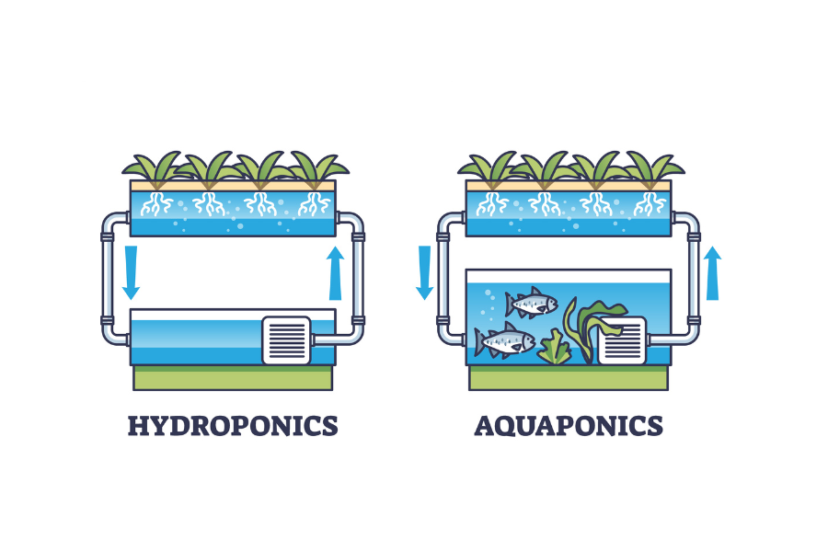Aeroponics vs Hydroponics: An In-Depth Comparison
Introduction to Modern Farming Techniques
There is often some confusion about aeroponics vs hydroponics and their similarities and differences. In this post, we will try to clear up that confusion and provide clarification regarding these two systems. Both aeroponics and hydroponics represent a significant shift from traditional farming, offering unique benefits and challenges. Let’s delve into their world, exploring their intricacies and how they stand apart.
Understanding Aeroponics
Aeroponics, a term that might sound futuristic, is a process where plants are grown in an air or mist environment without the use of soil. This technique hinges on delivering nutrient-rich mist directly to the roots, ensuring optimal growth conditions. But how does this system work in practice, and what makes it so effective?
Exploring Hydroponics
Conversely, hydroponics is a method of growing plants in a water-based, nutrient-rich solution, bypassing the need for soil. It’s fascinating to see how plants thrive in these controlled environments, with their roots directly immersed in nutrient solutions. Different hydroponic systems, such as wick, ebb and flow, and deep-water culture, cater to various plant types and grower preferences.
Comparative Analysis: Aeroponics vs Hydroponics
When comparing aeroponics vs hydroponics, several factors come into play. Space and environmental requirements differ significantly, with aeroponics often demanding more precise control. Water and nutrient usage is another critical factor. Aeroponics tends to be more efficient in water use, which is a boon in areas with water scarcity. Growth speed and plant health also vary, with aeroponics typically offering faster growth rates due to better oxygenation.
Benefits of Aeroponics
One of the most striking benefits of aeroponics is the accelerated plant growth it facilitates. This is mainly due to the constant and direct supply of nutrients and oxygen to the roots. Additionally, aeroponics systems generally have a lower risk of disease and pest infestations, given the lack of soil and reduced moisture on plant surfaces.
Advantages of Hydroponics
Hydroponics, on the other hand, shines in its ease of setup and maintenance. It’s a more established method, with a wider range of resources and community support available. The versatility in growing different types of plants is also a significant advantage, making it a preferred choice for many urban gardeners and commercial growers.
Challenges in Aeroponics
Despite its benefits, aeroponics is not without challenges. The technology involved is more complex, often requiring a deeper understanding of plant biology and system engineering. The initial costs can also be a deterrent, especially for casual enthusiasts or small-scale growers.
Challenges in Hydroponics
Hydroponics faces its own set of challenges, primarily in its dependency on water and electricity. This can be a significant concern in areas with limited resources. Additionally, managing nutrient solutions requires careful monitoring and adjustments to ensure plant health.
Economic Aspects
From an economic standpoint, both aeroponics and hydroponics present interesting opportunities. The initial investment might be higher for aeroponics, but the potential returns, especially in commercial settings, can be substantial. Hydroponics, being more accessible, offers a lower entry barrier for new entrants in the market.
Environmental Impact
Sustainability is a crucial factor in today’s agriculture practices. Both aeroponics and hydroponics offer advantages over traditional farming in terms of water usage and the potential for reduced chemical inputs. However, their energy requirements and potential carbon footprints differ, with aeroponics typically having a higher energy demand.
Future Prospects in Agriculture
Looking ahead, the role of technology in agriculture is set to grow. Innovations in aeroponics and hydroponics could play a pivotal role in addressing global food security challenges. The integration of smart technologies for monitoring and optimizing growth conditions is an exciting frontier.
Conclusion
In summary, both aeroponics and hydroponics offer compelling benefits and pose unique challenges. The choice between them depends on individual goals, resources, and commitment levels. As we continue to explore and innovate in these areas, the potential for transforming our food systems remains vast.
FAQs
Which is better for beginners, aeroponics or hydroponics?
For beginners, hydroponics is often the better choice. It’s generally easier to set up and maintain, with more straightforward technology and a wider range of accessible resources. Hydroponic systems also offer a bit more forgiveness for errors, which is ideal for those just starting out in soilless cultivation.
Can aeroponics be used for all types of plants?
While aeroponics is versatile, it might not be suitable for all plant types, especially those that require a lot of support or have very large root systems. It works best for plants with less demanding structural needs, such as leafy greens, herbs, and some fruits and vegetables. Researching specific plant requirements is crucial before starting an aeroponic system.
How significant are the water savings in aeroponics compared to traditional farming?
Aeroponics is highly water-efficient, often using up to 90% less water than traditional soil-based farming. This efficiency is due to the recycling of water in the system and the precise delivery of water and nutrients directly to the plant roots, minimizing waste.
Are hydroponic vegetables as nutritious as soil-grown ones?
Hydroponic vegetables can be just as nutritious as those grown in soil, if not more so in some cases. The nutrient content depends on the quality and composition of the nutrient solution used. With proper management, hydroponic systems can produce vegetables that are rich in vitamins and minerals.
What are the main environmental benefits of using hydroponics?
The main environmental benefits of hydroponics include reduced water usage since the water in the system is recycled and used efficiently. It also allows for reduced use of pesticides and herbicides, as soil-borne diseases and pests are less prevalent. Additionally, hydroponics enables farming in urban environments and areas with poor soil quality, making it a sustainable option for increasing local food production.




